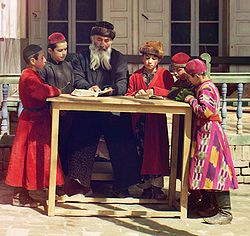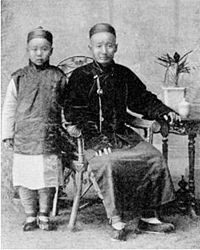Ethnogenesis, as the name implies, is the process whereby a new ethnic group is created. An ethnicity is more or less a group with a shared culture, belief in common ancestry, and that preferentially marries within itself rather than outside of itself. Over time, this creates a group that is ethnically distinct from its neighbors, even under conditions of close proximity.
The Amish, for example, after splitting off from the Swiss in the 1600s over religious differences (remember, religion is ethnicity,) arrived in Pennsylvania in the early 1700s, so we may mark Amish ethnogenesis around the mid 1600s or early 1700s People today make fun of Ben Franklin for complaining that the German-speaking immigrants to Pennsylvania were problematic and not integrating with the rest of the population, but you know, the Amish still haven’t integrated. They still speak German, follow their own religion and traditions, and don’t inter-marry with the rest of the Pennsylvania population, such that they are quite ethnically distinct, at least on a genetic level.
The Hui of China are another example; they were not really considered an ethnic group before the establishment of the People’s Republic of China circa 1949. The Chinese decided to just lump all of their Muslim minorities–some of them quite distinct–under one term. (Historically, the term “Hui” also referred to Christians and Jews and was just a general catch-all.) Hui now marry other Hui preferentially enough that the Wikipedia page goes into detail on known cases of inter-marriage with the Han, but a fellow Hui from across the country may be regarded as just another Hui, and so a preferred partner.
Anyway, so that got me thinking about the establishment of Israel. Normally when I think of Jews, I am actually thinking of Askenzim, and you probably are, too. But Israel is actually 61% Mizrahi Jews–Jews from predominantly Muslim countries.
You know the general story: Once upon a time, all of the Jews lived in Israel. These people were probably pretty similar, ethnically, to the Palestinians, assuming the Palestinians are anything like the region’s residents 2000 years ago, and don’t have a massive influx of Turkish DNA or something like that.
Then the Jews got conquered and scattered to the winds. Most famously after the destruction of the Second Temple by the Romans, but also during the Babylonian and Assyrian eras, etc. Anyway, for the past 2000+ years or so, there have been significant Jewish communities in a lot of places that aren’t Israel, eg:





Then in the late 1800s, the Jews–mostly Ashkenazim, I think–got sick of this state of affairs and decided to exit Europe and go back to Israel. Unfortunately, they didn’t really succeed until 1948, at which point Jews from all over the world started pouring in.
Since most people are genetically similar to their neighbors, eg the Palestinians and Syrians, or Han and She, I began wondering how similar Jews were to their neighbors of millenia verses their similarity to each other.
Here’s a graph showing major genetic lineages of a bunch of different ethnic groups, including several Jewish ones:
Broad cultural zones are easily distinguished, like East Asians in yellow, South Asia in greens, Europeans with their large dark blue chunk, Middle Easterners with their big patches of light green and light blue, and the rust-tones in sub-Saharan Africa. This data set is great, because it lets us compare various Jewish groups to their immediate neighbors, eg:
I made a condensed version of the graph that highlights the measured Jewish groups and their neighbors, (sadly, some of the samples are pretty small, making them hard to read):
And an even more condensed version that just compares the Jews to each other:
(Note that the pure green section on the right-hand side is not a Jewish group, but just a chunk of the graph that happened to overlap the text due to the Cochin Jewish section being so small.)
Observations: Most Jewish groups are significantly more similar to their immediate neighbors than they are to other Jewish groups, especially when we look at the furthest-flung folks. Cochin Jews and Ethiopian Jews, for example, show almost no DNA in common (in this graph.)
Given what all Middle Eastern groups look like in the sample, we may speculate that the original Jewish group primarily had a large section of light blue and a slightly smaller section of light green, with probably a smidge of sub-Saharan. Several of the Middle Eastern Jewish groups still have this genetic makeup.
Three Jewish groups show a more European makeup, with a large dark blue chunk characteristic of Europeans and North Africans: the Ashkenazim, Sephardim, and Moroccan Jews. They look closest to Cypriots, though I compared them to Spaniards and Tuscans as their nearest neighbors in the graph.
Since the Ashkenazim are estimated to be about half Italian, it’s not surprising that they have about half as much dark blue as the Italians. Even within European groups, while they look fairly similar at this level of resolution, some groups are quite distinct from each other–Italians and Germans, for example, or Brits and Greeks. Geneticists can determine whether your ancestors were Italians or Germans or Greeks just by looking at your DNA, but those kinds of small details don’t really show up all that well on a graph that is trying to show the differences between Sub-Saharan Africanss and Asians. So while Moroccans, Sephardim, and Ashkenazim all look rather similar here, there may be finer grained differences that just don’t show up at this scale.
What’s up with the Moroccan Jews? They do not look like Moroccans; I therefore speculate a more recent migration of Moroccan Jews from somewhere else that’s not Morocco, like Spain.
The Jews who migrated to the East, however, lost a significant portion–almost all–of their light blue component, replacing it with dark green more typical of Indians and other SE Asian populations.
I don’t think this dataset contains Uzbeki Jews (or the Lemba, who are not Jewish enough to be considered Jewish, but still have a few Jewish traditions and folktales and a bit of Jewish ancestry,) which is sad, but I’d wager the Uzbeki Jews look a lot like other Uzbeks.
One of the things I’ve heard often from Jews is that all Jews are Jews, part of one great big Jewish family descended from Abraham (even the atheist ones!) and thus Jews should always try to be kind to each other, all Jews are welcome in Israel, etc. This is a perfectly sensible philosophy when you’re a peasant in Poland and the only foreign Jews you’ve ever met were from Lithuania. But 2000+ years of diaspora have resulted in far flung groups becoming quite ethnically distinct from each other. Like the Amish, isolated groups in Cochin or Ethiopia have become their own ethnies distinct from their ancestors, but unlike the Amish, they have inter-married significantly with the locals. (The Amish do not marry non-Amish.)
The Roman Exile, therefore, should be regarded as a major ethnogenesis event–the beginning of the creation of most current Jewish ethnic groups.
The creation of the state of Israel constitutes a second major ethnogenesis event, a bringing together of these multiple ethnic groups into one population that views itself as one population. I expect a great deal of mixing between these historically distinct groups into a more homogenous whole, (though some groups may not mix terribly well.)




I’ve heard from some of my Jewish friends that Moroccan Jews are a mix between Spanish Jews and all the Jews living along the Muslim side of the Mediterranean. Seems about right based on how they look.
OT: In a previous post I mentioned that white men’s brains age poorly for the same reason bricklayers age poorly, due to overworking the organ. You responded by asking whether lazy people live longer. I went digging through my old hard drive because I had link saved relating to this question. Sadly the links are broken or go to pages that do not cite sources. From what I remember, lazy people do live longer, depending on how one defines laziness. If one defines laziness the way Europeans do, then no, you will probably die of a heart attack or stroke from sitting on your ass all day eating potato chips and drinking soda. If one defines laziness the way Amerifats do, then yes, you will live longer because you take more vacation time, enjoy regular siestas and generally maintain lower stress levels. The take away was that Americans (and Protestant Germanic countries) overwork themselves in comparison to Catholic Mediterranean Europe. That’s all I’ve got.
LikeLike
Thanks for trying to look it up! Interesting thoughts. :)
LikeLike
[…] Source: Evolutionist X […]
LikeLike
I don’t think that peasantry was the most popular occupation among Polish Jewry.
LikeLike
Plenty of Jewish peasants in Poland back in the day.
“In Lithuania and Estonia, the Jewish masses lived mainly in densely populated towns where anti-kabbalistic (mysticism) rabbinical academic culture (in the yeshivot) flourished …. In Poland itself, the Jews tended to live scattered in villages far removed from intellectual centers.” –Wikipedia (https://en.wikipedia.org/wiki/Hasidic_Judaism) The whole Hasidic thing got started among Polish (and other east-European) peasant Jews who saw themselves in contrast to the urban Jews from Lithuania. (Hence the name for the overly-legalistic Jews who opposed Hasidism, “Litvaks”, which is really just “Lithuanians.”) There was a big conflict between the city Jews and peasant Jews over Hasidism back in the 17 and early 1800s.
LikeLike
Even in those villages they preferred other occupations like small crafts and trades.
LikeLike
I’d venture to say that the vast majority of modern Jews are not descended from the ancient Hebrews. My guess would be that their most likely descendants are the Palestinian and Egyptian Christians. What is your speculation?
LikeLike
I’d put my money on a majority of Jews being half ancient Jew and half local population, an effect of the first men to migrate to the area having taken gentile wives. Genetic testing shows that Ashkenazim are probably about half Italian, for example. (Funny thing is the Ashkenazim can tell, even without looking at DNA; they joke about how Italian they are.) As for the ancient Jewish stock, that was probably simply the people who lived in the land of Israel/Judea back in the day, who are probably also the ancestors of today’s modern Palestinian people (Palestinians clearly resemble the people around them, like Saudis, Bedouins, and Jordanians, but that is no guarantee that they haven’t all had some kind of admixture over the past 2,000 years or more.)
However, the out-marrying has picked up tremendously in the US since 1950; the majority of American Jews are now marrying non-Jews. As a result, America’s Jewish stock will soon be majority non-Jewish in DNA if it isn’t already.
LikeLike
Of all the Jewish groups, I’d say the Ashkenazi are the least likely to be descended from the ancient Hebrews. Look to the populations that had large Hebrew populations in antiquity, and you will likely come closer: Rome, Alexandria, Ethiopia, etc. The Ashkenazi were from central Europe and Asia which probably had virtually no Hebrew population in antiquity.
LikeLike
For the Ashkenazim, we have both the historical records and genetics. They’re half Middle Eastern, half Italian. They migrated to Italy after the destruction of Israel, married Italian women, and then moved to Germany. We have a lot of documents on the subject because the German mayors often invited them there officially, as part of the whole planned town thing that went into the Otsiedlung.
The genetic evidence does not reflect a Khazar origin for the Ashkenazim. Khazaria was located in modern day Russia/the Caucuses. Two Caucus countries are in the graph, Georgia and Armenia. They have a broad strip of green, similar to Iran and Turkey. Russians have a chunk of yellow that they share with virtually all other Asians, and a giant chunk of dark blue. As you move into the steppe, you find a lot of really mixed-up genetics. (Take the Uzbeks, for example.)
The Ashkenazim have neither a broad strip of green (like the people of the Caucuses) nor a big chunk of dark blue like the Russians, nor the generally mixed up pattern of steppe peoples. Rather, they most closely resemble (on this graph, anyway,) Cypriots, suggesting a combination of Middle Eastern and Euro-Mediterranean DNA.
By contrast, the Ethiopian, Cochin, Mumbai, and Lemba Jews are far more divergent from Palestinians and other Middle Easterners, which is reflected in the pictures.
LikeLike
Oh! I just realized that I forgot about different breeding rates–the Ashkenazi Jews who marry other Jews have far more children than the Jews who marry out. Those tend to be your “Ultra-Orthodox” types, who are very different from your typical SJW Reform types. Given that the UOs tend to have, like, 5 kids, and the Reform/atheists have <2, Jewish DNA will probably remain at close to 50% of people who actually attend synagogue.
Sorry. My bad.
LikeLike
[…] Evolutionist X wonders whether gender dimorphism is a luxury good. To some extent it certainly is. I think the ability to pretend gendered do not arise principally out of biological factors is even more expensive. Also, a lot detail here in Judeo Ethnogenesis. […]
LikeLike
[…] to any particular ethnic groups. (It’s even more mixed up than Jewish, and that’s a pretty mixed up one after thousands of years of inter-breeding with […]
LikeLike
[…] as a distinct nation. As I’ve discussed before, this is not exactly genetic, due to different Jewish groups having absorbed about 50% of their DNA from the folks around them during the diaspora years, and of course a big part of the country is […]
LikeLike
[…] have cultural connections, but genetically they are quite diverse. The situation is similar with Jewish groups. 2000 years ago, most Jews were genetically “Jewish,” but today, the vast majority of […]
LikeLike
[…] lived somewhere 2,000 years ago is nonsense–during the 1,900 years of diaspora, pretty much all Jewish groups intermarried with their neighbors and are now about 50% “non Jew” by DNA (most of that on their […]
LikeLike